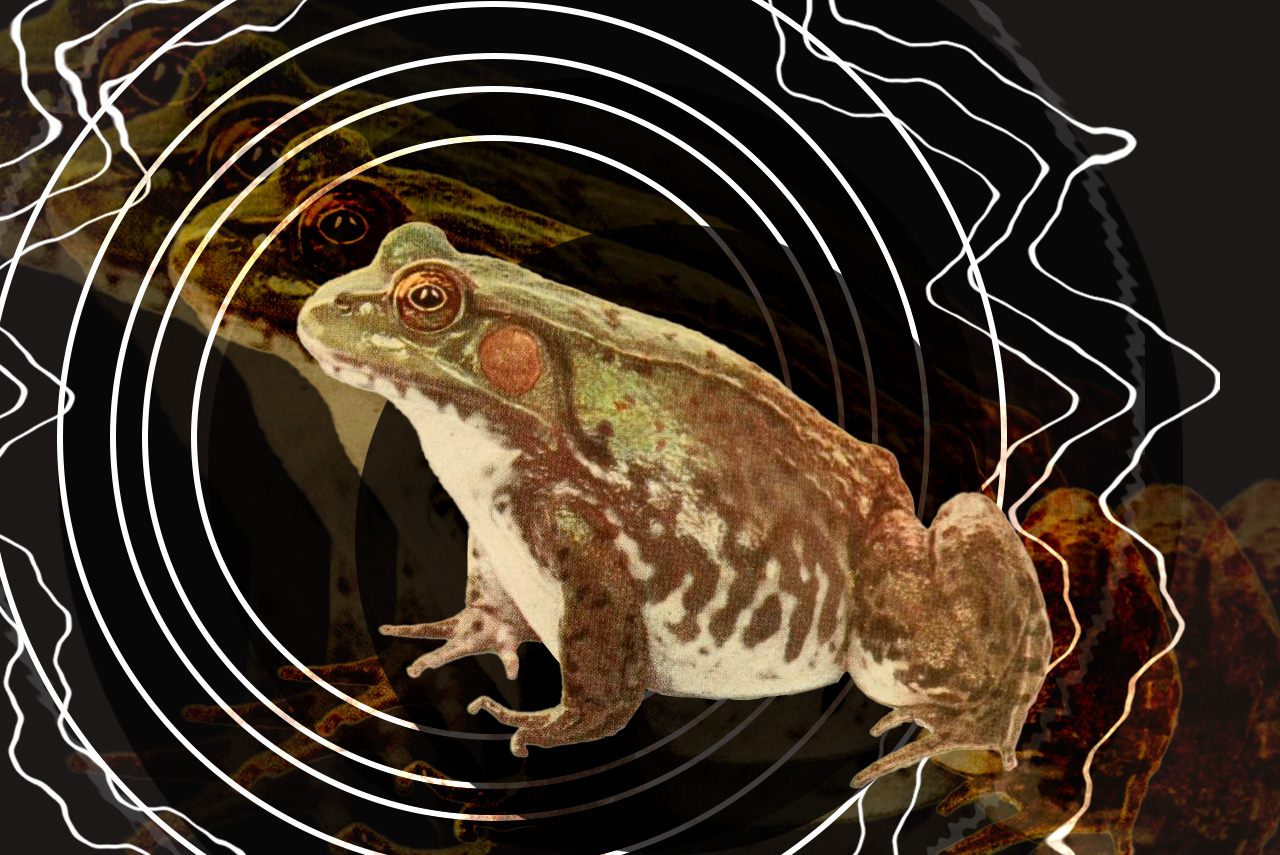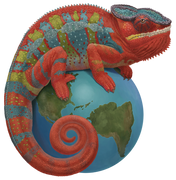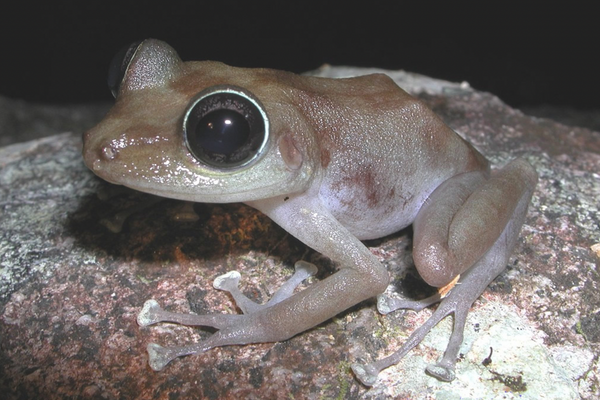The Many Lives of ‘Sounds of North American Frogs’
This metamorphic record is a teaching tool, a flirtation device, a college radio favorite, a nostalgic object, and more. BOOP!

It was late on July 16, 1957, and Charles M. Bogert was in a recording booth in Highland County, Florida, with a pair of singers who wouldn’t sing. The burgeoning producer, who had left a busy life in New York to chase talent in the Sunshine State, had heard the two perform live that very evening, in a chorus of hundreds. He had plucked them from the crowd, and thenushered them out of the swampy night and into this soundproofed room. But his would-be stars—out of their element, lacking inspiration—were silent. So Bogert took out a pair of headphones and played them a recording of their own voices from earlier, amid the chorus. Instantly they began an unrestrained duet: BOOP! BOOP! BOOP — WAMP — BOOP — WAMP — BOOP — WAMP!
The booper here is a barking treefrog (Hyla gratiosa), while the wamper is a hybrid frog, thought to be the offspring of a barking and a green treefrog (Hyla cinerea). Theirs is a standout performance on Sounds of North American Frogs, originally released on Smithsonian Folkways Recordings in 1958, and re-released at the end of 2023 by the same label.
Frogs themselves are not the only ones charmed by these recordings. Over the decades, the album—which features nearly 100 frog and toad calls, chirps, croaks, and screams from across the continent, each framed by Bogert’s voice—has picked up many fans, from burgeoning herpetologists to college radio DJs. It is “one of the top-selling titles” from the Folkways back catalogl, says production manager Mary Monseur.
The First Voice in Existence
Sounds of North American Frogs features contributions from hundreds of amphibians, dozens of people, and the occasional session-crashing bird or cricket. But it was mostly the work of two obsessed men, Bogert and Moses Asch.
Asch, the founder of Folkways Records, spent his life putting together what he called a “a depository of the sounds and music of the world.” Early releases, of drum solos and logging camp songs and folk music from Palestine, Haiti, France, and Ethiopia, were joined by recordings that were less traditionally musical. Later titles included Science Fiction Sound Effects Record and End the Cigarette Habit through Self-Hypnosis. (The Smithsonian Institution acquired the 2,168-item catalog after Asch’s death, on the condition that they would ensure every recording could be made available on demand.)
Sometime around the early 1950s, Asch met Bogert, the curator of amphibians and reptiles at the American Museum of Natural History in New York. Among zoologists, Bogert was an early adopter of the portable tape recorder, which set him up well to participate in Asch’s burgeoning “Science Series.” This had begun somewhat unscientifically, with Sounds of a Tropical Rain Forest in America, patched together from recordings made of birds at the Bronx Zoo, crickets in Connecticut, and—when there was a need for more rain sounds—a Manhattan bathtub lined with newspaper.

Bogert pursued accuracy rather than vibes. He really wanted listeners to get into the vocal stylings of frogs, animals that, as he wrote in the record’s introductory essay, probably possessed “the first voice in existence,” from tens of millions of years “before man had the wit to chop out an arrow point.” The record takes the form of a lecture: carefully recorded calls alternating with Bogert’s explanations of who is making them, how, and why it matters. The liner notes describe the lengths that he went to in order to record his subjects—grabbing gopher frogs to elicit their serrated warning croaks, paddling a dugout canoe into Lake Pátzcuaro in Mexico to bottle the Pátzcuaro frogs’ winter mating chorus, and handling tense studio moments like the one described above, which happened at Florida’s Archbold Biological Station.
Absolutely Ribbiting
Frogs use calls to find each other, identify members of their own species, express personal and territorial boundaries, and attract mates. Listening to Sounds of North American Frogs, it’s possible to understand how a dedicated listener can begin to decode these messages. With Bogert’s help, one can learn to differentiate not only between the chirr of the pickerel frog and the rumble of the giant toad, but even between the screeches of Fowler’s toads in Arkansas and North Carolina. (Both sound like they’re auditioning to die in a slasher film, but the North Carolina toad is going to get the part.)

The record’s release, in 1958, was “an important event for herpetology,” inspiring future research and enabling helpful ear training, says David Hillis, an evolutionary biologist at the University of Texas at Austin. As a young aspiring biologist, Hillis memorized the record, along with a similar one from 1953. He even adopted some of the frogs’ methods. “When I first met my wife-to-be, Ann, in 1976, I invited her up to my dorm room to listen to my records of frog calls,” he wrote in a recent paper. She declined that particular invitation, but the two now share his original copy, one of the few records they’ve kept from those days.
From a scientific perspective, the record is “still a good introduction to frog calls,” and probably the best audio summary available, Hillis says. But advances in technology mean that experts now have many more high-quality recordings to choose from in online databases and sound libraries. Methods have changed as well. While songs were once widely used to distinguish separate species among closely related frogs, now genetic analyses are more likely to do that work.

One frog that Bogert refers to as a separate subspecies was recently proven through genomics not to qualify, says Max Lambert, a conservation research scientist in the Pacific Northwest who works on amphibians and was part of that study. Researchers also frequently mix tools: “These days we rely heavily on call analyses to take species with large ranges and verify whether species-splitting we identify with genetics can also be heard in their calls,” Lambert says.
Some tracks on the record have gained special significance. “The American bullfrog is one of the most invasive and harmful species on Earth, and Bogert’s recording is from Yuma, Arizona, where it’s not native,” Lambert says. “At the time of the recording, the ecological devastation caused by the bullfrogs wasn’t really understood at all.” (In fact, according to the liner notes, Bogert himself introduced some bullfrogs to a pond in California in 1930.) Now, Lambert says, researchers “deploy piles of acoustic recorders” to track the invading frogs in sensitive areas across the Western United States—but, unlike Bogert, they would rather not hear them.
Genre Hopping
Over the years, Smithsonian got enough requests for the record that they released it on CD in 1998, Monseur says.
This spurred another wave of interest, this time well beyond the herpetology world, driven by underground sound artists and college radio DJs. As Smithsonian senior archivist Jeff Place remembers it, music magazine CMJ briefly introduced a “Frog of the Week” column. “People were clamoring for it,” he says. (“Yes, the Smithsonian’s notorious frog call collection is back in print,” one review celebrated, while another predicted it would be “greeted ecstatically by those who have long since worn out their LPs: biologists, musicologists, and hippies.”)
Virginia Tech sociologist and WUVT radio DJ Liam Weikart (aka Dr. Moolenbeek) remembers downloading the record online in the early 2000s, “in the context of experimental music,” he says. “The online blogosphere for this kind of thing was raging” at that point, and it was easy to grab mp3s of “weird field recordings,” like this or fellow Folkways classic Sounds of the Junk Yard. (Bogert’s approach wasn’t to Weikart’s specific taste: “Any single recording of any frogs on there, I would take 60 minutes of that over hearing a guy talk,” he says. But he did just buy it on Bandcamp anyway, for old time’s sake.) Musicians continue to engage with the record: Electronic duo Matmos just released an album made up of samples from a variety of Smithsonian Folkways records, and hardcore legend Henry Rollins regularly begins his KCRW radio show with Bogert’s frogs.
This most recent re-release of Sounds of North American Frogs is available digitally and on vinyl. For the physical record, the team at Folkways worked to create liner notes and packaging “as close to the original” as they could, says Monseur, a frog-to-prints process that involved converting old paint chips into hex-coded digital colors and recreating typefaces that never made the transition to digital fonts.

This fastidiousness was in service of preserving a historic object, but also a response to a contemporary malaise that, in general, is helping drive today’s vinyl revival—a sense that “everything feels disposable, and so nothing feels meaningful,” says Monseur. Asch’s records had a heft and texture that was “more substantial,” she says. “People love that feeling.”
For this contemporary fan, engaging with the record produces a temporally amphibious effect, like dipping in and out of eras. Seeing “Barking Treefrog (Hyla gratiosa)” listed as an artist on Spotify is funny in a way that feels of this moment. The record’s human elements, visual and tactile and narrative, do effectively slingshot you back to the 1950s, inspiring a certain nostalgia for a time that, if nothing else, contained far more frogs.
But the most impactful leap comes when the needle drops—bringing, across both 65 years and 10 million, a truly undeniable sound, the closest thing we know to the first voice on Earth: BOOP. BOOP. BOOP!
Cara Giaimo writes about plant and animal science and culture across the Internet, and lives with her wife and two cats in Somerville, Massachusetts.

















Follow us on Twitter to get the latest on the world's hidden wonders.
Like us on Facebook to get the latest on the world's hidden wonders.
Follow us on Twitter Like us on Facebook